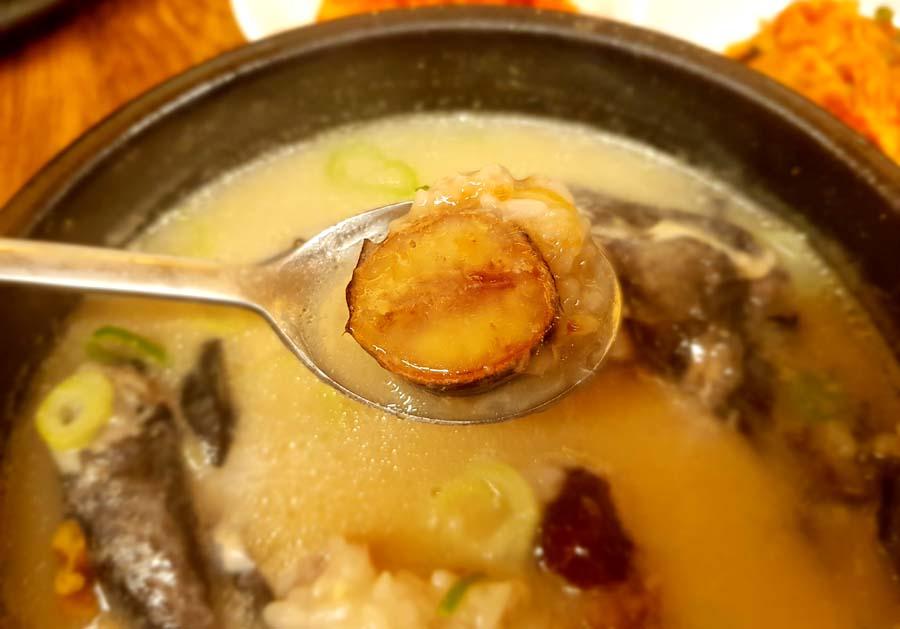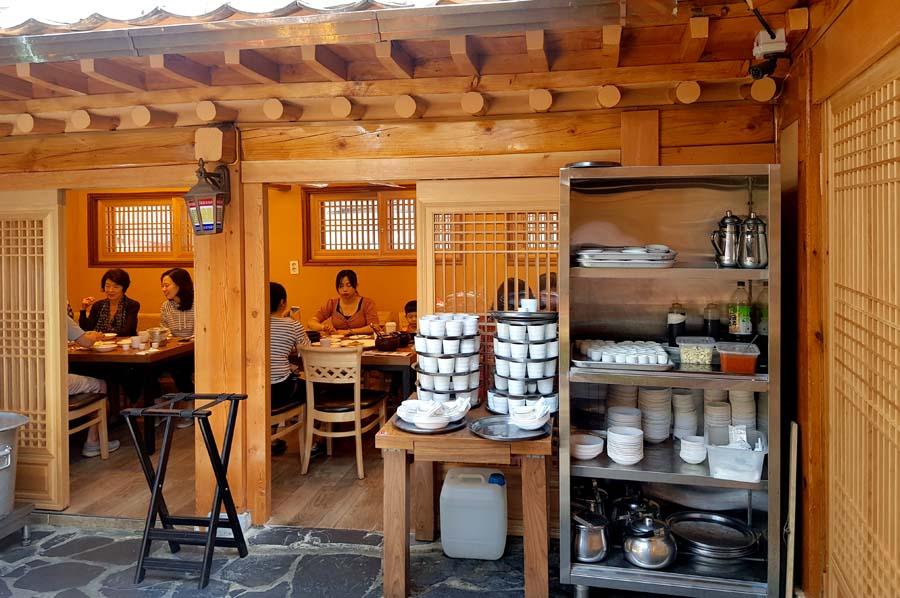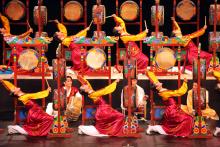Primary tabs
Three Dog Days in Korea (Sambok) and the Most Popular Sambok Dish- Samgyetang
Likes: 0

If you have watched Korean dramas and movies or are otherwise interested in the country, you probably know about the Korean holidays of Seollal and Chuseok. But have you heard of Sambok? Although the term may sound unfamiliar to you, it’s related to Korea’s famous hot summers. We already covered naengmyeon, the most popular summer food to beat the heat in a cool way. This time, Stunning Korea will help you learn how to beat Korea’s heat in a hot way!

What is Sambok?
In the past, most Koreans depended on farming for their livelihood. All able-bodied members of the family worked in the fields during the growing season between spring and fall. During the summer heat, field work became nearly impossible, so everyone would take a short break during the hottest part of the days and eat a nourishing meal designed to cool off the body and build stamina.
The word sambok refers to the 3 hottest days of the summer, also called the “dog days” of summer. These days also represented the peak of the growing season. The days are not consecutive, but happen over a month-long period. The specific days occur according to the lunar calendar. The first day (called chobok) occurs on the 10th day of the 6th lunar month. The second day (jungbok) occurs 10 days later, with the final day (malbok) coming an additional 20 days after that.

What did Koreans do on Sambok?
Due to the extremely hot weather, the royal court distributed ice to high-ranking officials on sambok days. Farmers were given a holiday, and many went to cooler places to try to escape the heat. Usually, the common people would visit a nearby mountain valley or the beach, spending a short summer vacation enjoying a cool mountain stream or sea breeze. In many cases, the large extended family vacationed together.
These days, the tradition has changed and sambok days are no longer holidays. However, people still try to beat the heat by eating different types of rejuvenating foods. For temporary relief, many people opt for cold drinks and food, particularly naengmyeon, patbingsu (shaved ice with sweetened red beans), and more recently ice cream. However, according to Eastern medicine concepts, although the body is warm, the internal organs are comparatively cooler, so you should eat food that warms the inner body to help restore energy and prevent illness.

Restaurants specializing in sambok-related foods attract a large number of customers during the hot summer days. Many people traditionally ate boshintang (dog meat stew, which helped associate it the term “dog days”), although the practice is much less common these days. Other popular dishes include jangeogui (grilled eel), yukgaejang (spicy beef soup with vegetables), chueotang (boiled mud fish soup), seolleongtang (ox-bone soup), jeonbukjuk (abalone porridge), patjuk (red bean porridge), and different types of summer fruits (especially melons). But from the 1960s, by far the most popular dish is samgyetang (chicken ginseng soup).


What is Samgyetang?
Differing from the typical chicken soup found in the West, samgyetang uses a whole young chicken (one chicken per individual serving), stuffed with ginseng, garlic, jujube dates, and rice. The chicken is served in a bowl with the water broth from cooking. This hot dish was designed to not just warm your insides, but also to induce perspiration for even more health benefits. The earliest recipes used ginseng powder instead of fresh ginseng roots. However, by the 1960s, the ubiquity of refrigeration in South Korea made fresh ginseng easier to get and store, leading to a change in the recipe and an increase in the dish’s popularity.
 Besides tasting great, the specific combination of ingredients provide a wealth of nutrition and health benefits. Although it may sound strange to eat hot food when the weather is also hot, eating lots of cold food can actually be bad for you and cause health issues. Eating hot food helps to increase blood circulation in the internal organs. Chicken meat is known as a “warm” food, which helps strengthen the 5 major organs (heart, lungs, liver, kidneys, and spleen). Ginseng is not only good for regaining your energy and strength, but it also helps control high blood pressure and prevent cancer. Garlic similarly has many cancer-fighting elements and is packed with other nutrients that can help lower blood pressure and the risk of heart disease, as well as detoxify the body. Jujubes have high amounts of vitamin C, iron, and calcium, plus are good sources of tannins (which help reduce inflammation and infection). The glutinous rice provides energy and strengthens the digestive system. Who knew a bowl of soup could be so healthy!
Besides tasting great, the specific combination of ingredients provide a wealth of nutrition and health benefits. Although it may sound strange to eat hot food when the weather is also hot, eating lots of cold food can actually be bad for you and cause health issues. Eating hot food helps to increase blood circulation in the internal organs. Chicken meat is known as a “warm” food, which helps strengthen the 5 major organs (heart, lungs, liver, kidneys, and spleen). Ginseng is not only good for regaining your energy and strength, but it also helps control high blood pressure and prevent cancer. Garlic similarly has many cancer-fighting elements and is packed with other nutrients that can help lower blood pressure and the risk of heart disease, as well as detoxify the body. Jujubes have high amounts of vitamin C, iron, and calcium, plus are good sources of tannins (which help reduce inflammation and infection). The glutinous rice provides energy and strengthens the digestive system. Who knew a bowl of soup could be so healthy!




The chicken comes mostly intact, so you will need to remove the chicken meat from the bones. The flesh should separate from the bones easily. You can eat the skin or discard it if you want to avoid the extra fat. A small dish with salt and pepper is used for dipping the chicken meat according to individual taste (although some people just add the seasonings directly into the broth). Make sure you eat the stuffing from inside the chicken to gain all the health benefits from the dish.
If you would like to beat the heat and experience an authentic samgyetang meal, even without having to wait for one of the three “dog days” of summer, Stunning Korea can help. Request a Custom Tour! Share your personal experiences and pictures in the Comments section below.

What is Sambok?
In the past, most Koreans depended on farming for their livelihood. All able-bodied members of the family worked in the fields during the growing season between spring and fall. During the summer heat, field work became nearly impossible, so everyone would take a short break during the hottest part of the days and eat a nourishing meal designed to cool off the body and build stamina.
The word sambok refers to the 3 hottest days of the summer, also called the “dog days” of summer. These days also represented the peak of the growing season. The days are not consecutive, but happen over a month-long period. The specific days occur according to the lunar calendar. The first day (called chobok) occurs on the 10th day of the 6th lunar month. The second day (jungbok) occurs 10 days later, with the final day (malbok) coming an additional 20 days after that.

What did Koreans do on Sambok?
Due to the extremely hot weather, the royal court distributed ice to high-ranking officials on sambok days. Farmers were given a holiday, and many went to cooler places to try to escape the heat. Usually, the common people would visit a nearby mountain valley or the beach, spending a short summer vacation enjoying a cool mountain stream or sea breeze. In many cases, the large extended family vacationed together.
These days, the tradition has changed and sambok days are no longer holidays. However, people still try to beat the heat by eating different types of rejuvenating foods. For temporary relief, many people opt for cold drinks and food, particularly naengmyeon, patbingsu (shaved ice with sweetened red beans), and more recently ice cream. However, according to Eastern medicine concepts, although the body is warm, the internal organs are comparatively cooler, so you should eat food that warms the inner body to help restore energy and prevent illness.

Restaurants specializing in sambok-related foods attract a large number of customers during the hot summer days. Many people traditionally ate boshintang (dog meat stew, which helped associate it the term “dog days”), although the practice is much less common these days. Other popular dishes include jangeogui (grilled eel), yukgaejang (spicy beef soup with vegetables), chueotang (boiled mud fish soup), seolleongtang (ox-bone soup), jeonbukjuk (abalone porridge), patjuk (red bean porridge), and different types of summer fruits (especially melons). But from the 1960s, by far the most popular dish is samgyetang (chicken ginseng soup).


Differing from the typical chicken soup found in the West, samgyetang uses a whole young chicken (one chicken per individual serving), stuffed with ginseng, garlic, jujube dates, and rice. The chicken is served in a bowl with the water broth from cooking. This hot dish was designed to not just warm your insides, but also to induce perspiration for even more health benefits. The earliest recipes used ginseng powder instead of fresh ginseng roots. However, by the 1960s, the ubiquity of refrigeration in South Korea made fresh ginseng easier to get and store, leading to a change in the recipe and an increase in the dish’s popularity.


Here’s a fun aspect of Korean food culture- in the olden days, samgyetang was associated with “mother-in-law” cooking. Back then, it was a tradition that a mother-in-law would kill one of her chickens and make samgyetang out of it when her son-in-law came to visit. These days, very few Koreans raise their own chickens, but many still follow the tradition. So Koreans feel a special emotional connection with samgyetang, associating it with a mother-in-law’s love.


How to Eat Samgyetang?
In restaurants, the dish is served in a bowl with the chicken’s legs tied up to keep the stuffed ingredients from spilling into the broth. Some places also include a small glass of ginseng liquor- you can drink it by itself or pour it into the broth. Side dishes of kkakdugi (radish kimchi) and regular kimchi are usually served as well.
If you would like to beat the heat and experience an authentic samgyetang meal, even without having to wait for one of the three “dog days” of summer, Stunning Korea can help. Request a Custom Tour! Share your personal experiences and pictures in the Comments section below.
You must join this group to see the full content or post comments.
 Forward
Forward Twitter
Twitter Google+
Google+ LinkedIn
LinkedIn
